Kapustnyak, or Kapusniak, is one of the heartiest soups I know! It is sharp, smokey and comforting, a great soup to enjoy at the end of a long day. Ukrainians took advantage of inexpensive, widely available and highly nutritious fresh or fermented cabbage and made a lot of dishes with it.
I grew up eating this soup every few weeks. Grandma made it with sauerkraut stored in barrels for winter and whatever pork meat or soup bones she had on hand. I always enjoyed a bowl of Kapustnyak with a dollop of sour cream and a slice of crusty bread, and I don’t know anyone who didn’t love it. I hope you like it too!
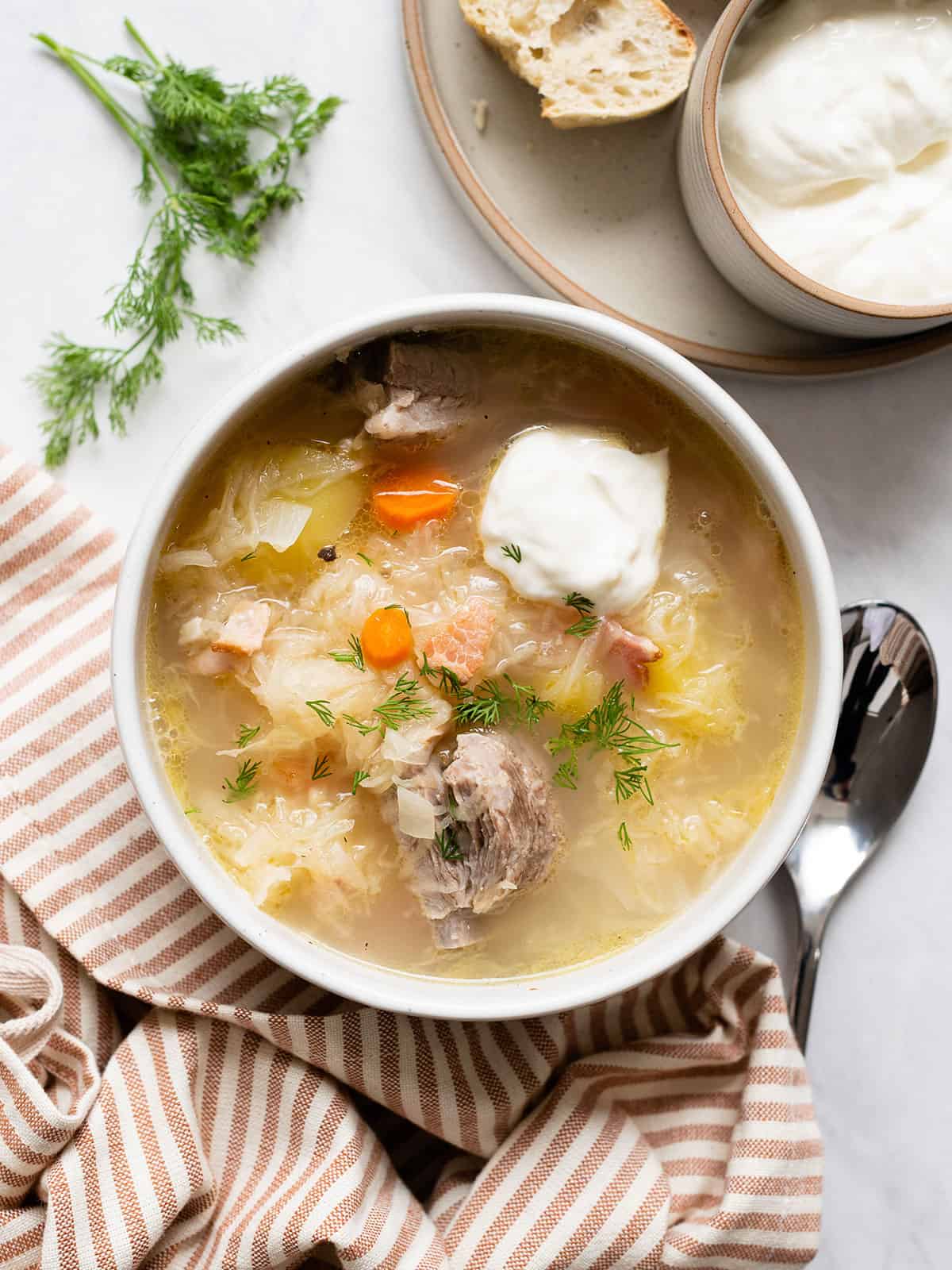
This post contains some affiliate links, which means that we make a small commission off items you purchase at no additional cost to you.
What is Kapusniak?
Kapustnyak is a hearty Ukrainian sauerkraut soup with pork and vegetables. It is a very rich, dense, and delicious dish that even picky eaters love.
The main ingredients in kapustnyak are sauerkraut and pork. Then various root vegetables like onion, carrot, potatoes, and garlic are added. In Ukraine, we ate soup every day year-round. Kapustnyak is more of a winter soup because fresh produce is not available during colder months. Rather everyone had cold storage full of root veggies and pickled goods including sauerkraut.
Kapustnyak is seasoned very simply. In Central Ukraine, we used “salo”, cured with salt pork fat similar to bacon or lard, to saute the veggies in. It adds an immense amount of flavor along with cooked pork and broth. Then we add garlic, salt, pepper and dill. Also the juices from sauerkraut add a ton of flavor to the broth.
There are a few other versions of Kapustnyak. One of them is thickened with a roux of butter and flour, resulting in a thick broth. Zaporizhzhian kapustnyak contains millet. Another variation is to add white beans.
What kind of meat can be used in Kapusniak?
If pork ribs are not available, you can use any cut of pork, like pork chops, in their place. Kielbasa would also taste good, but that would be more like the Polish version of kapustnyak.
If ribs are too expensive, 6-7 slices of bacon is another great option. It will add a good amount of pork flavor and fat kapustnyak relies on.
You can also use fewer ribs, about 1 lb., to make this recipe more budget-friendly, or even pork soup bones.
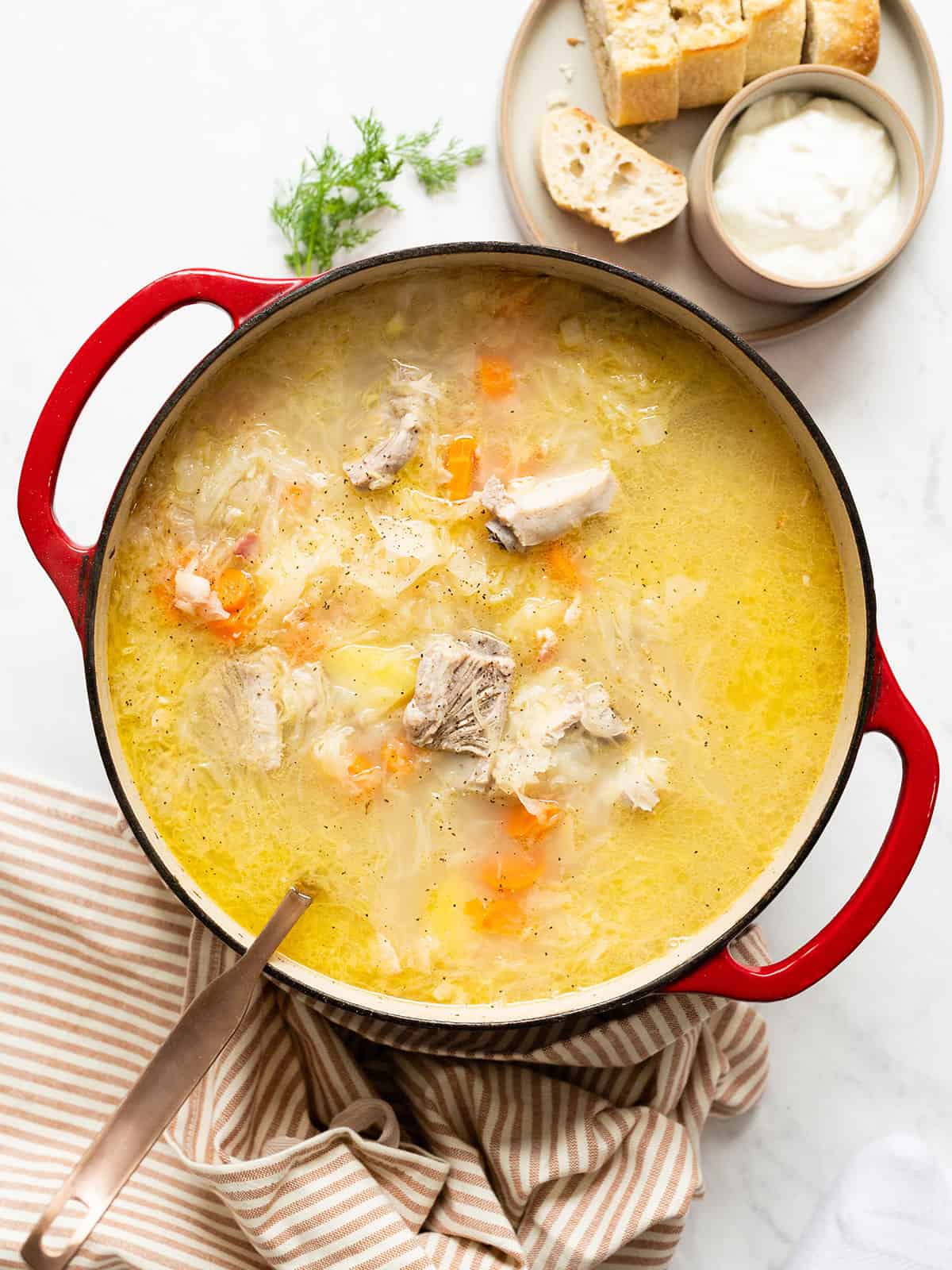
What Kind of Sauerkraut to Use
Make sure to buy regular sauerkraut, also known as German sauerkraut, in regular grocery stores. Ingredients should be “cabbage and salt”. Do not buy sauerkraut in white wine. There is no need to rinse or drain the sauerkraut. Use all the juices for maximum flavor.
What else can you add to Kapusniak?
Here are some other great ingredients that you can add to kapustnyak to take it to the next level:
- Allspice: In some regions in Ukraine add 1/2 to 1 teaspoon of allspice.
- Thicker soup: It is common to see an addition of 2 tablespoons of millet, a bit of mashed potatoes, or all-purpose flour to thicken the soup.
- Fresh cabbage: Some people like to add 1-2 cups of shredded raw green cabbage to make it taste fresher and resemble borscht.
- Fresh parsley: If you don’t have fresh dill, feel free to use fresh parsley. I do not recommend using dried dill weed as its taste is very strong and bitter. In Ukraine, it is used mostly for pickling. Or omit fresh herbs altogether, soup will be delicious anyways!
What to serve with Kapusniak
Serve kapustnyak very warm with a dollop of sour cream and a slice of rye bread, Pampushky, or fresh crusty bread like a baguette. This hearty soup is a meal on its own!
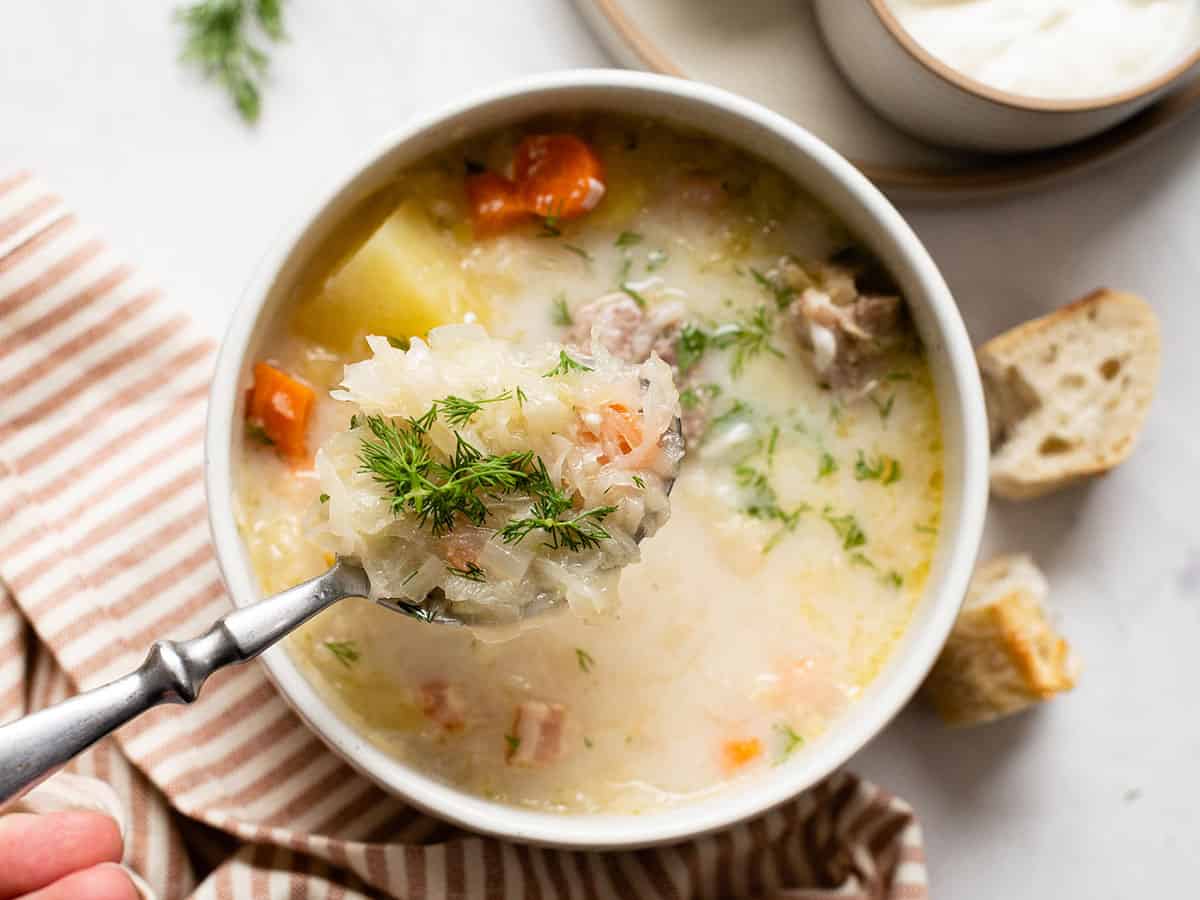
Kapusniak
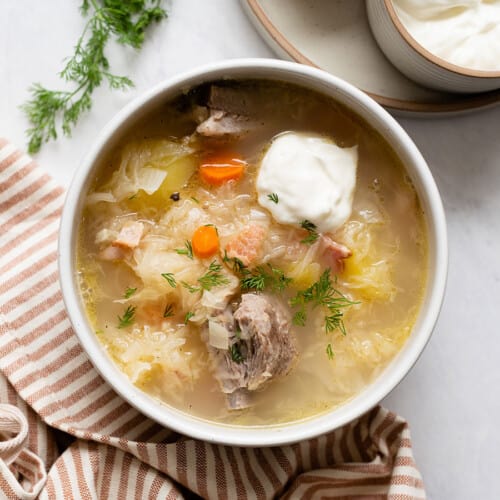
Ingredients
- 2 lbs. pork short ribs or pork side ribs ($5.98)
- 12 cups water ($0.00)
- 3 bay leaves ($0.45)
- 2 slices bacon* ($0.80)
- 1 large yellow onion, chopped ($0.37)
- 2 large carrots, chopped ($0.29)
- 4 large potatoes, peeled and cubed (2" cubes) ($1.19)
- 4 cups sauerkraut (or one 28oz. jar) ($1.74)
- 1 tsp salt (or to taste) ($0.05)
- 1/2 tsp freshly ground black pepper ($0.03)
- 1 Tbsp fresh dill (optional) ($0.27)
Instructions
- In a large pot, add the pork ribs, water, and bay leaves. Bring the water to a boil, then reduce the heat to low, cover and simmer for 45 minutes.
- Meanwhile, preheat a large skillet over medium heat and saute the bacon for 3 minutes, stirring occasionally. Add the onions and carrots, and saute for another 4 minutes, stirring occasionally. Set the bacon and vegetables aside.
- Remove the pork ribs from the pot, place them on a plate, and set them aside. Add the sauteed veggies, potatoes, garlic, sauerkraut, salt, and pepper to the pot with the broth. Bring to a boil and then cook on low heat covered for 20 minutes or until potatoes are fork-tender.
- Meanwhile, cut the cooled meat into small pieces. Add the chopped meat to the soup, stir, discard the bay leaves and adjust the salt to taste.
- Serve the soup hot with a dollop of sour cream and a slice of rye bread or baguette for dipping.
See how we calculate recipe costs here.
Notes
Nutrition
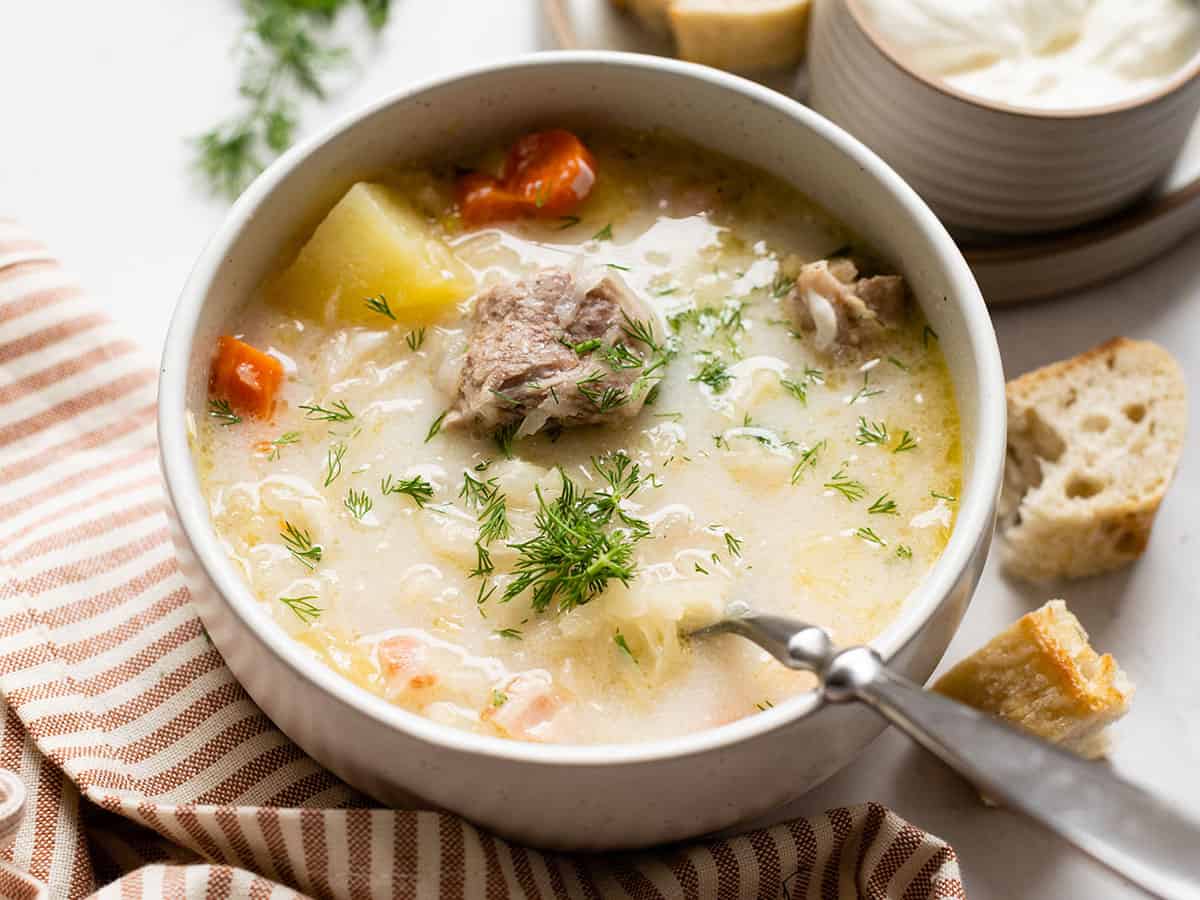
How to Make Kapusniak – Step by Step Photos
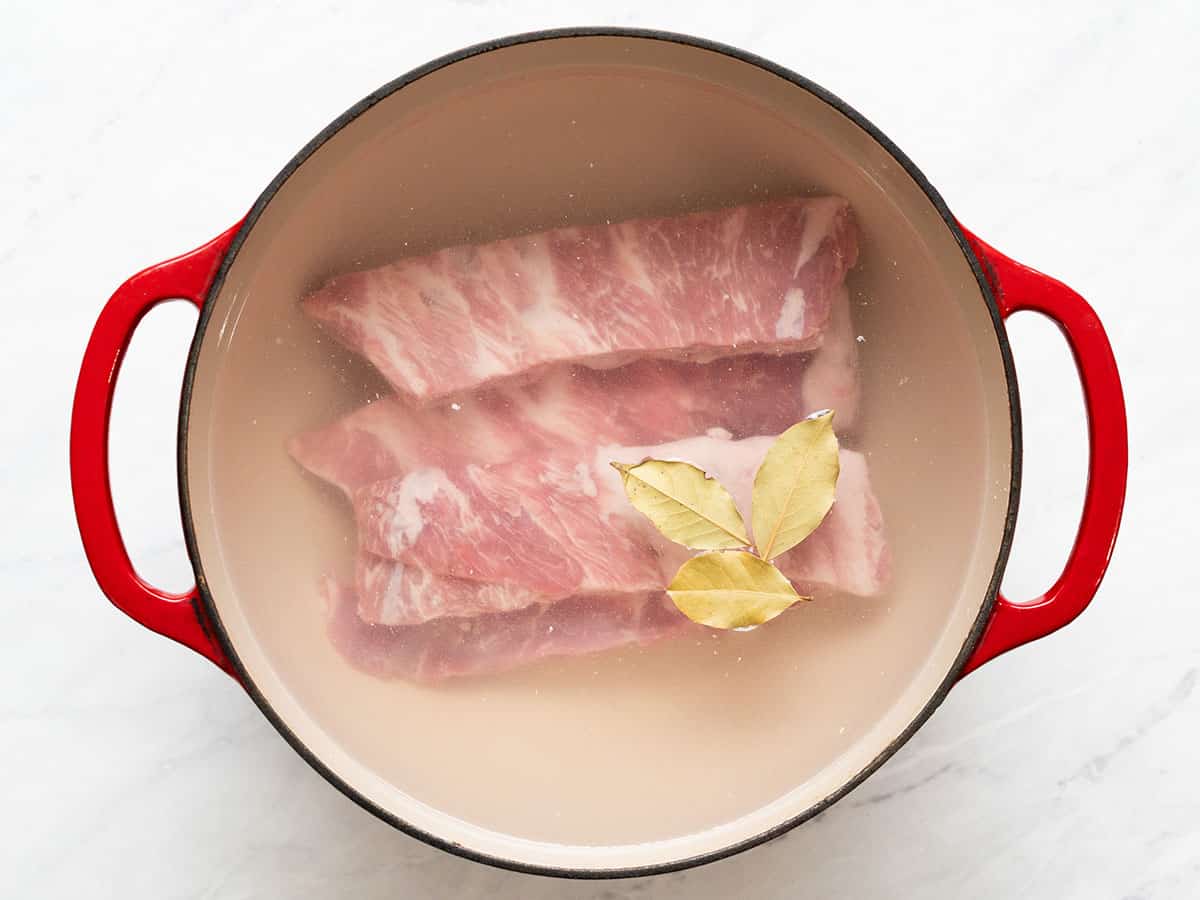
Add 2 lbs. pork ribs to a pot along with three bay leaves and 12 cups of water. Place a lid on top and bring the pot to a boil over high heat. Reduce the heat to low and let simmer for 45 minutes.
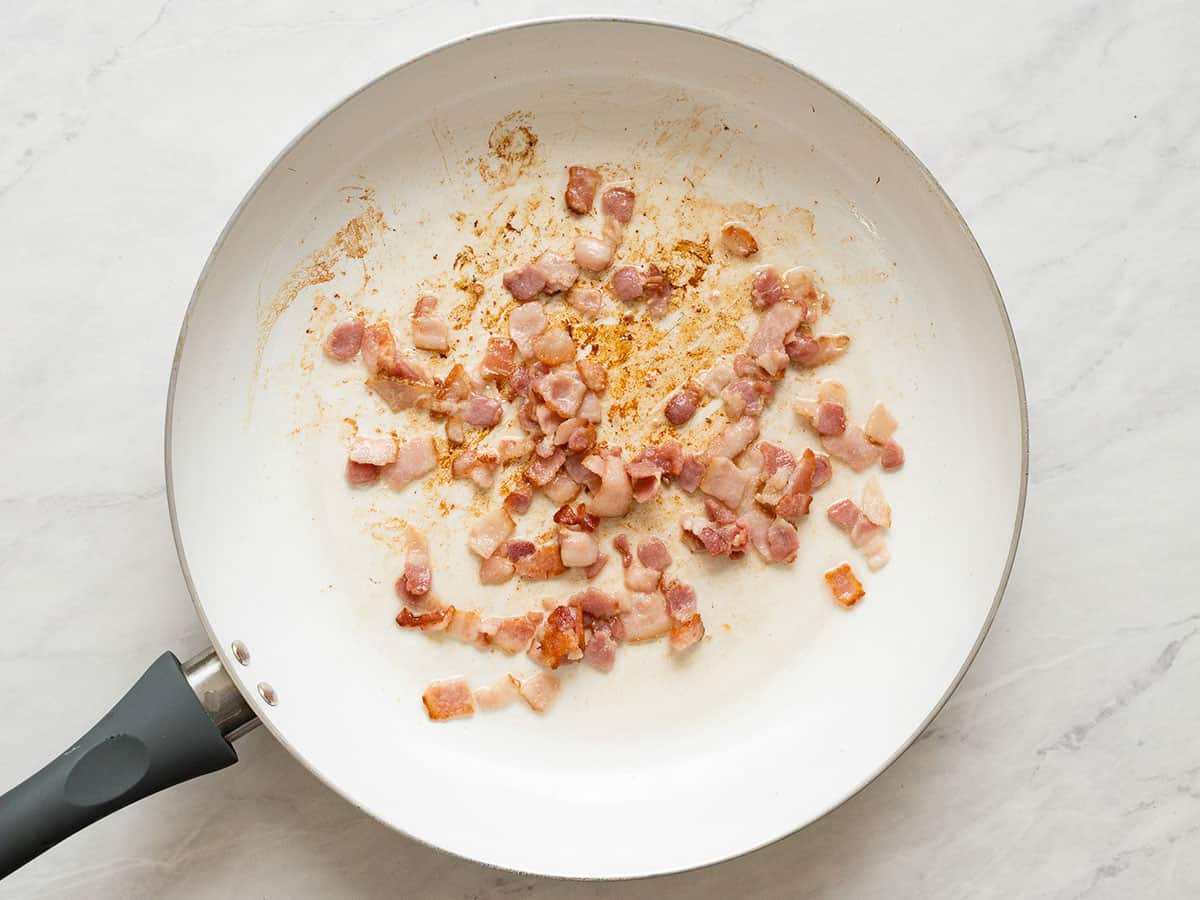
Meanwhile, chop two slices of bacon and cook in a skillet over medium heat for about 3 minutes to render some of the fat. If you don’t have bacon, you can just use 1 Tbsp olive oil.
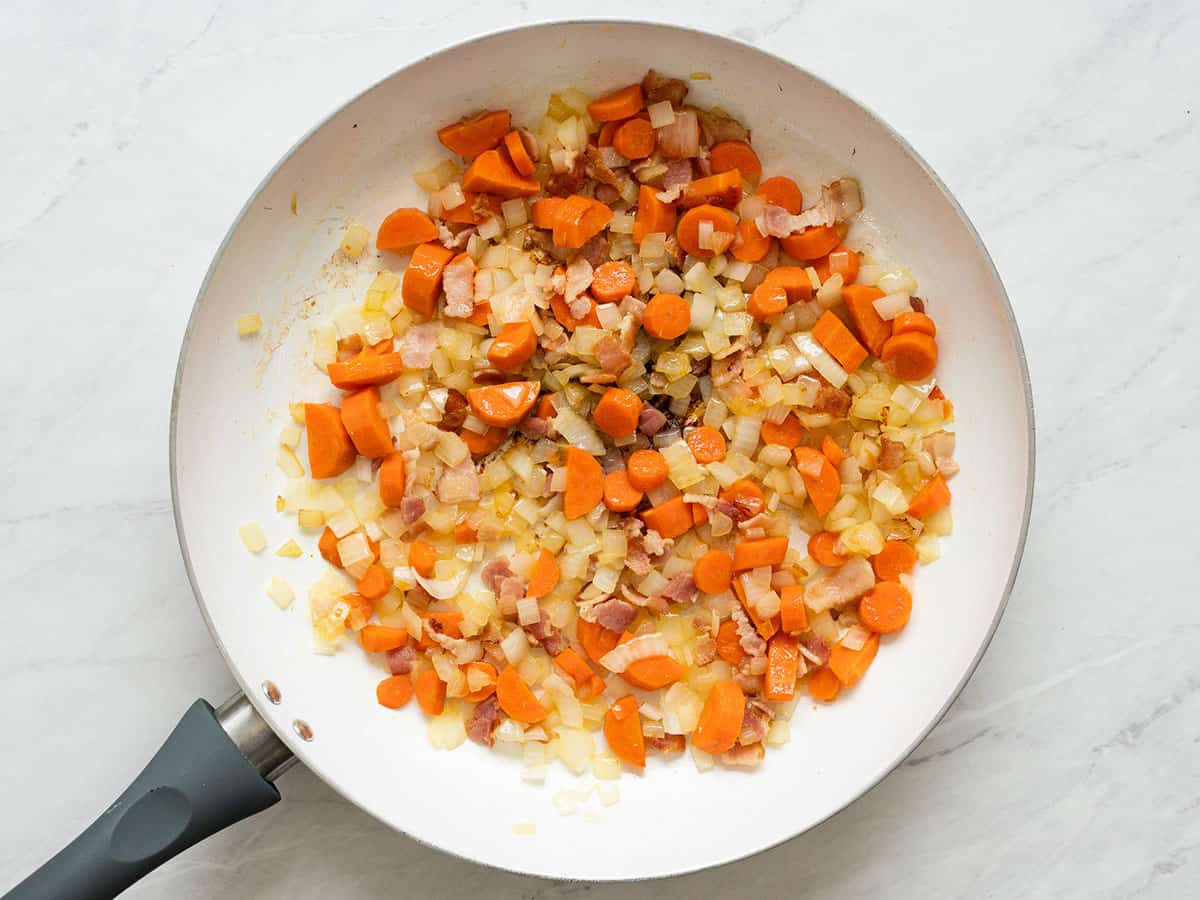
Add one large onion (diced) and two large carrots (chopped) to the skillet with the bacon and continue to sauté over medium for 4-5 more minutes.
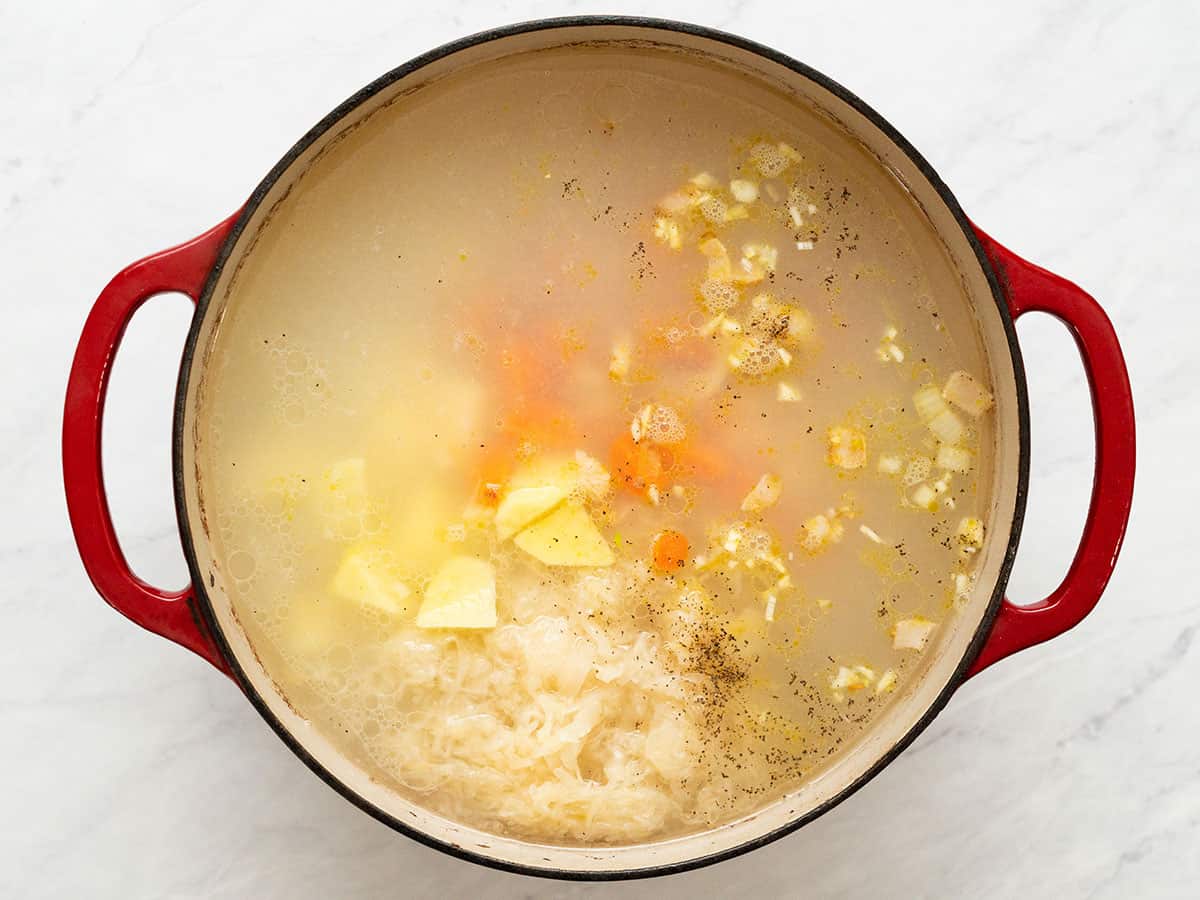
Remove the pork ribs from the pot. Add the sautéed bacon and vegetables, 4 large potatoes (cut into 2-inch pieces), 2 cloves of garlic (minced), and 28oz. sauerkraut, 1 tsp salt, and ½ tsp pepper to the pot. Place a lid on the pot and bring it to a boil over high heat, then reduce the heat to low and let simmer for 20 minutes or until the potatoes are fork-tender.
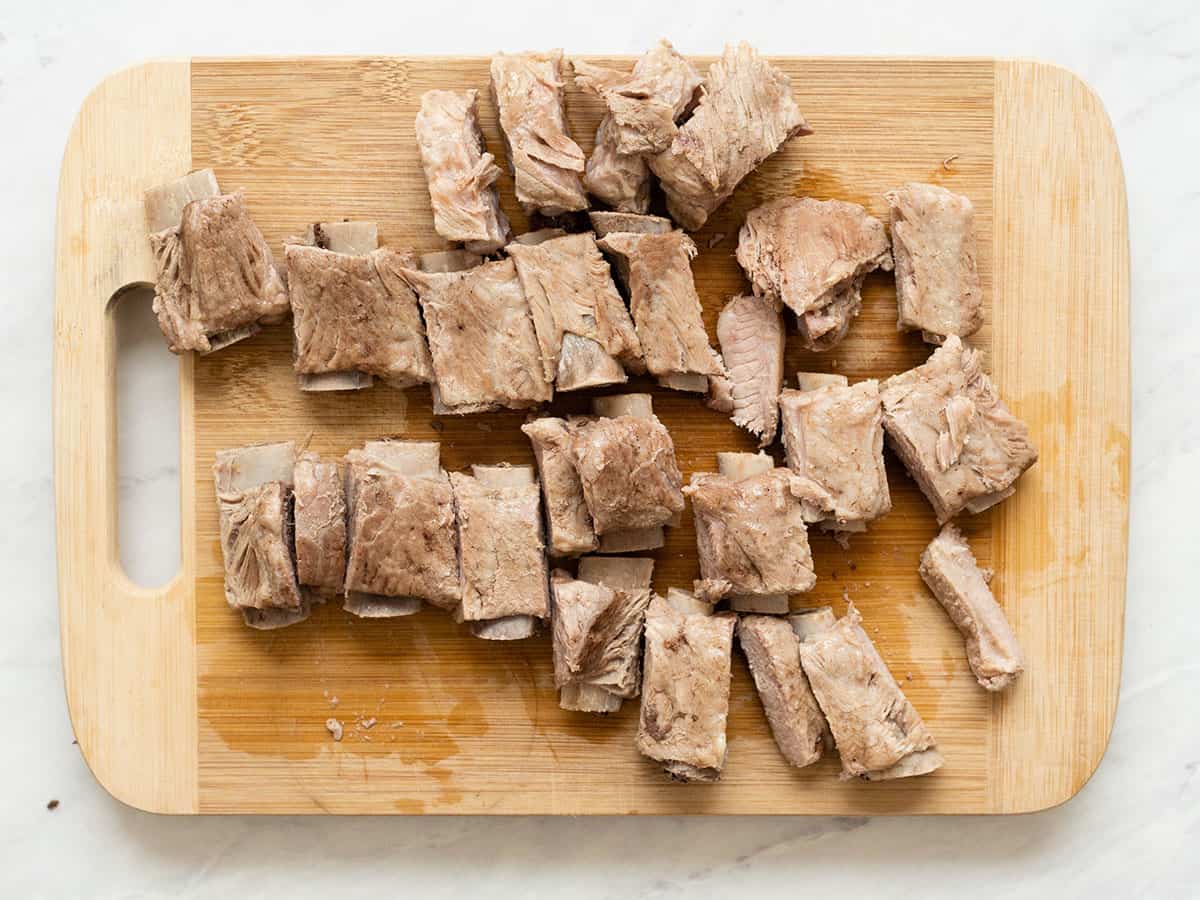
Meanwhile, cut the cooled pork ribs into small pieces.
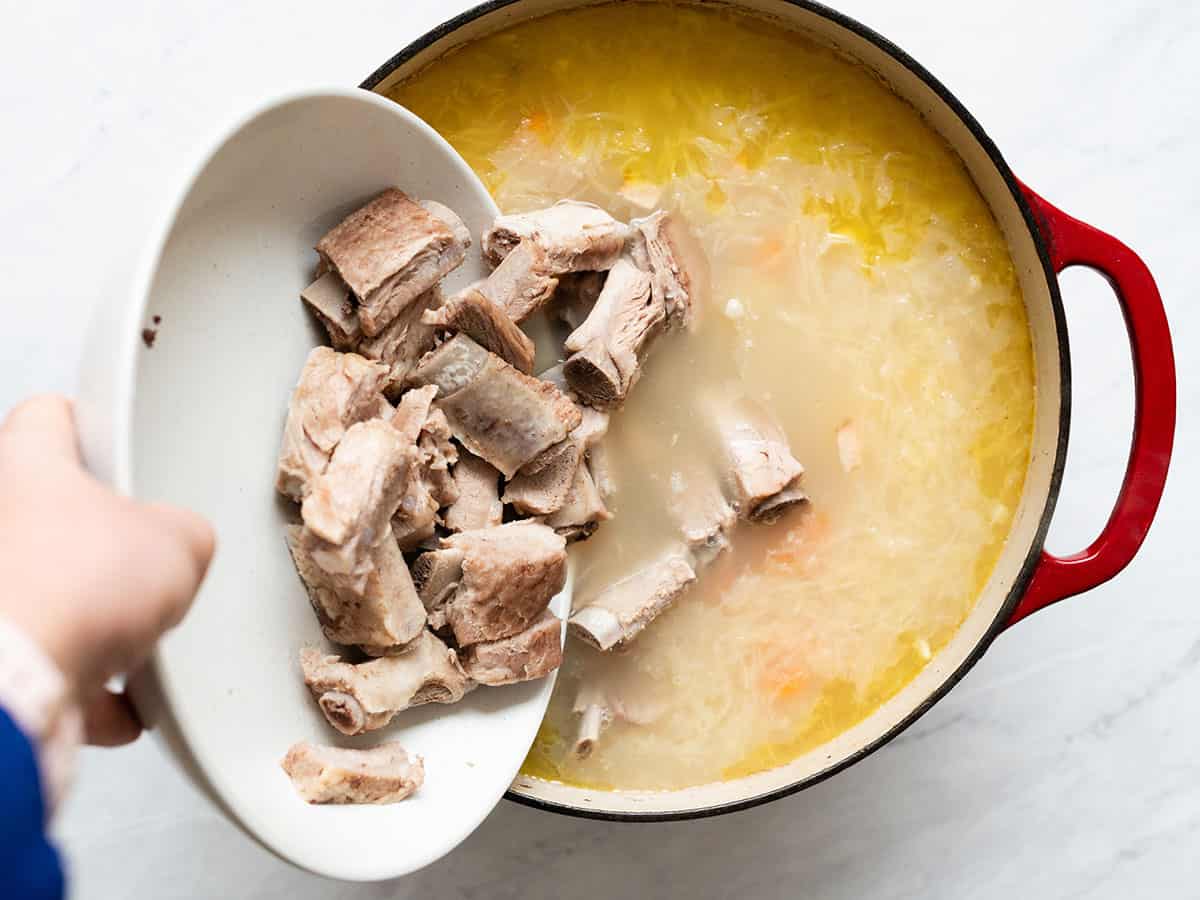
Remove the bay leaves, add the chopped pork ribs back to the soup, stir, and adjust the salt to taste, if you wish.
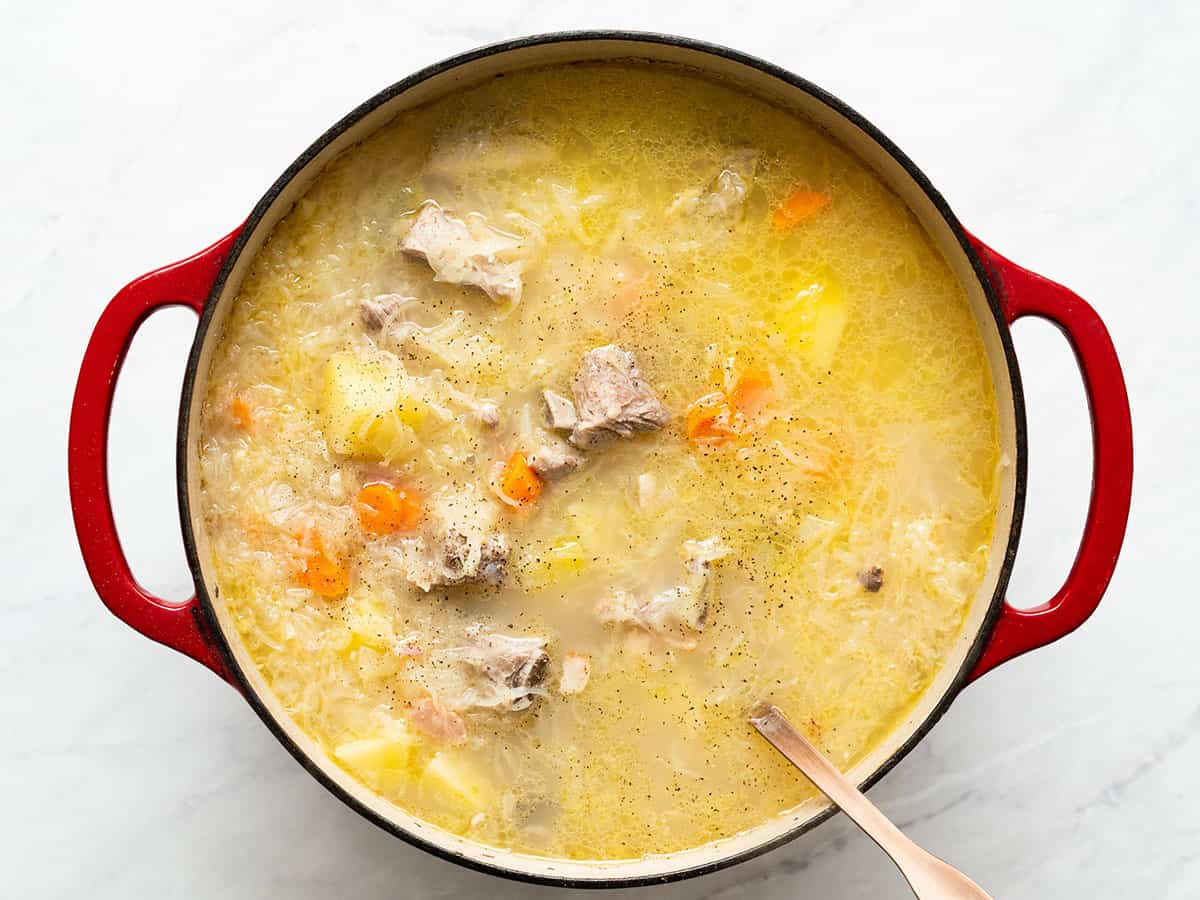
Serve the soup hot with some fresh dill, a dollop of sauerkraut, and some bread for dipping!
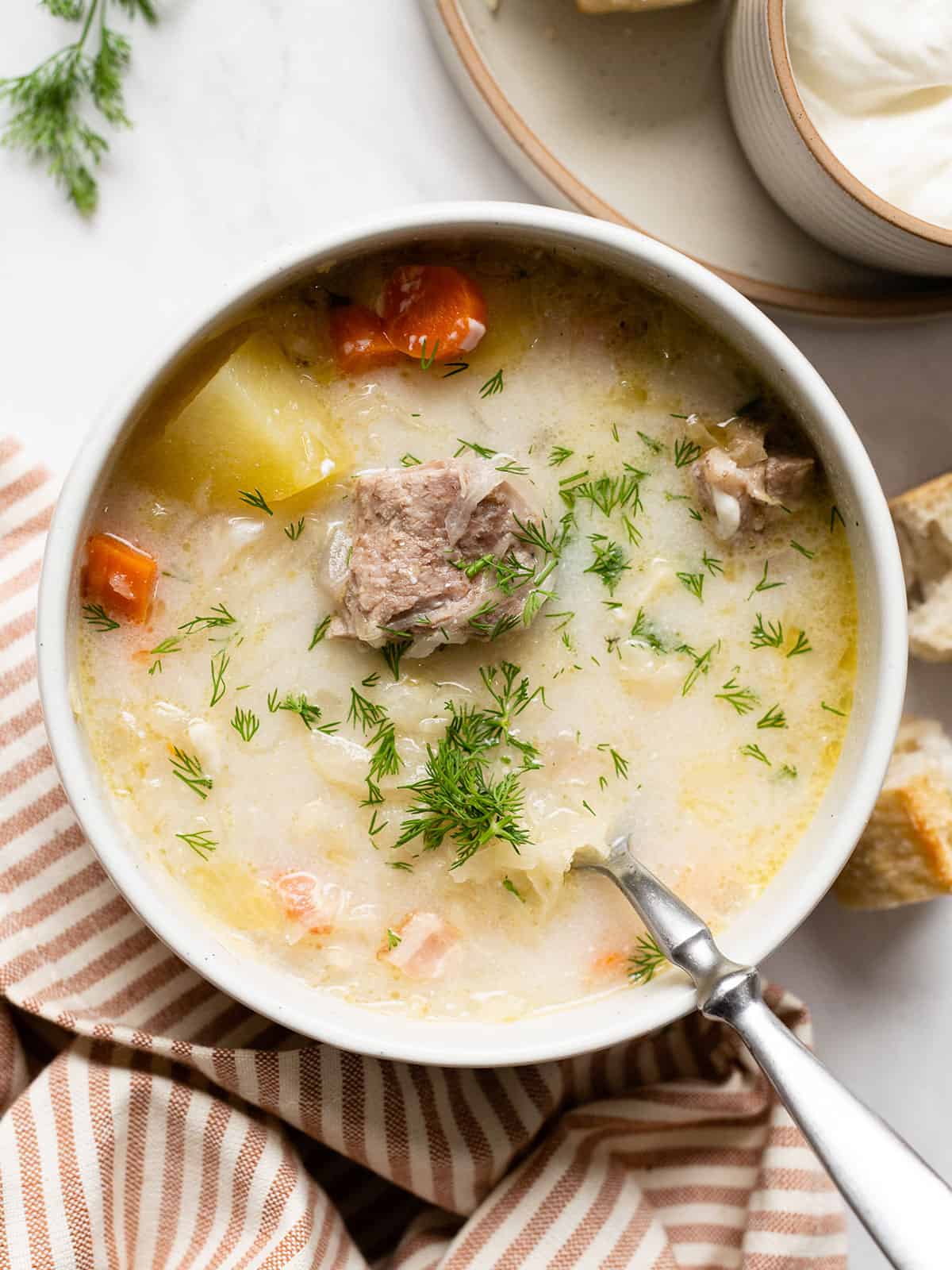


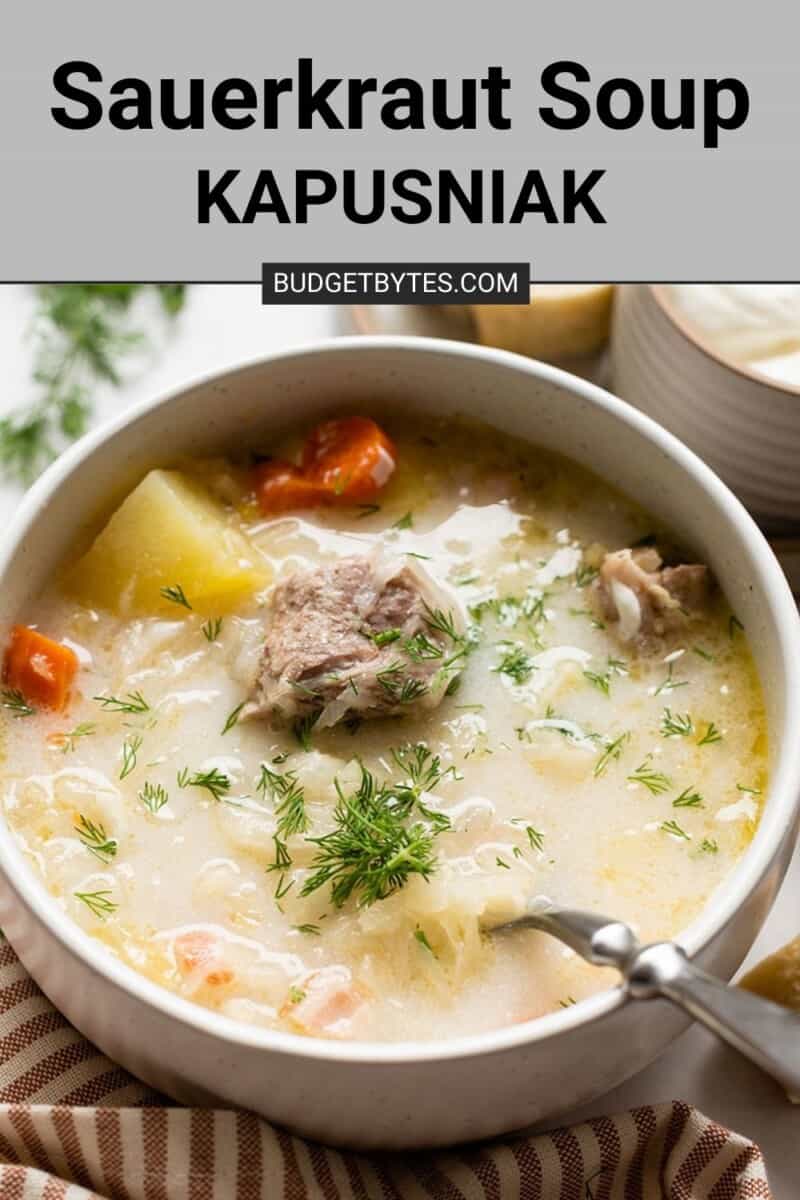
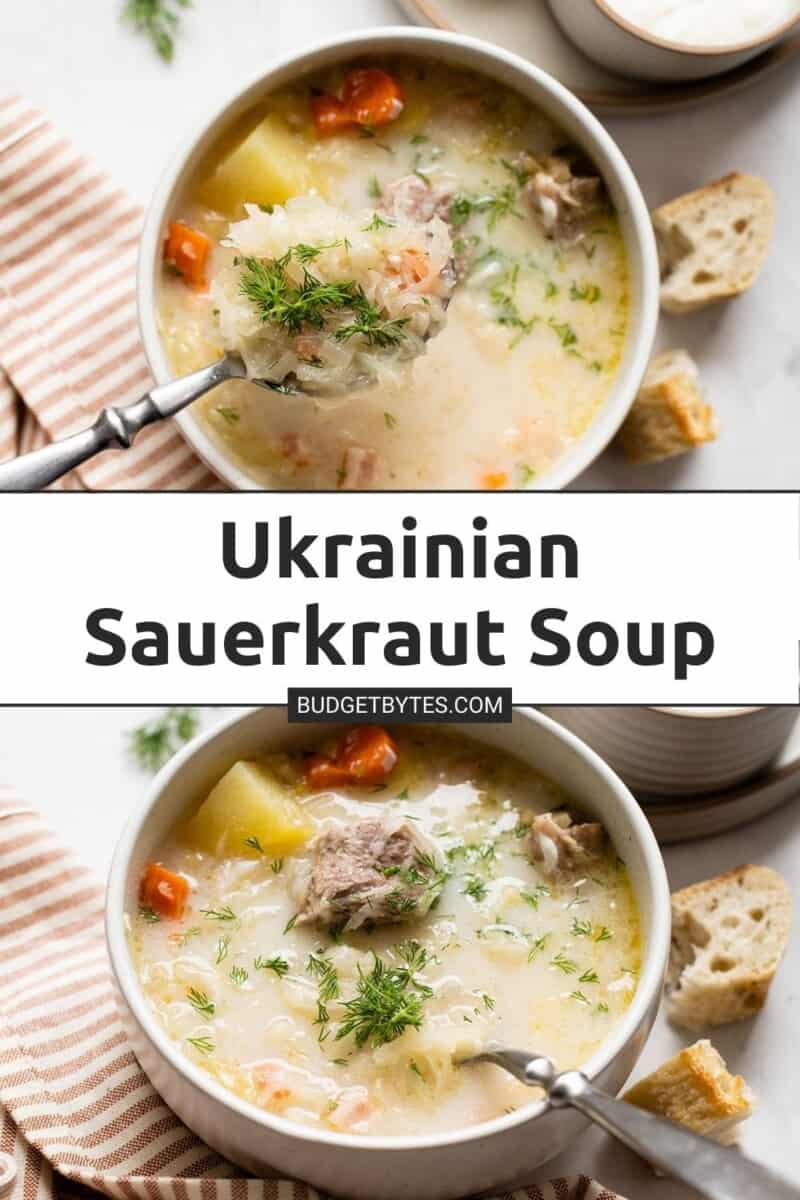
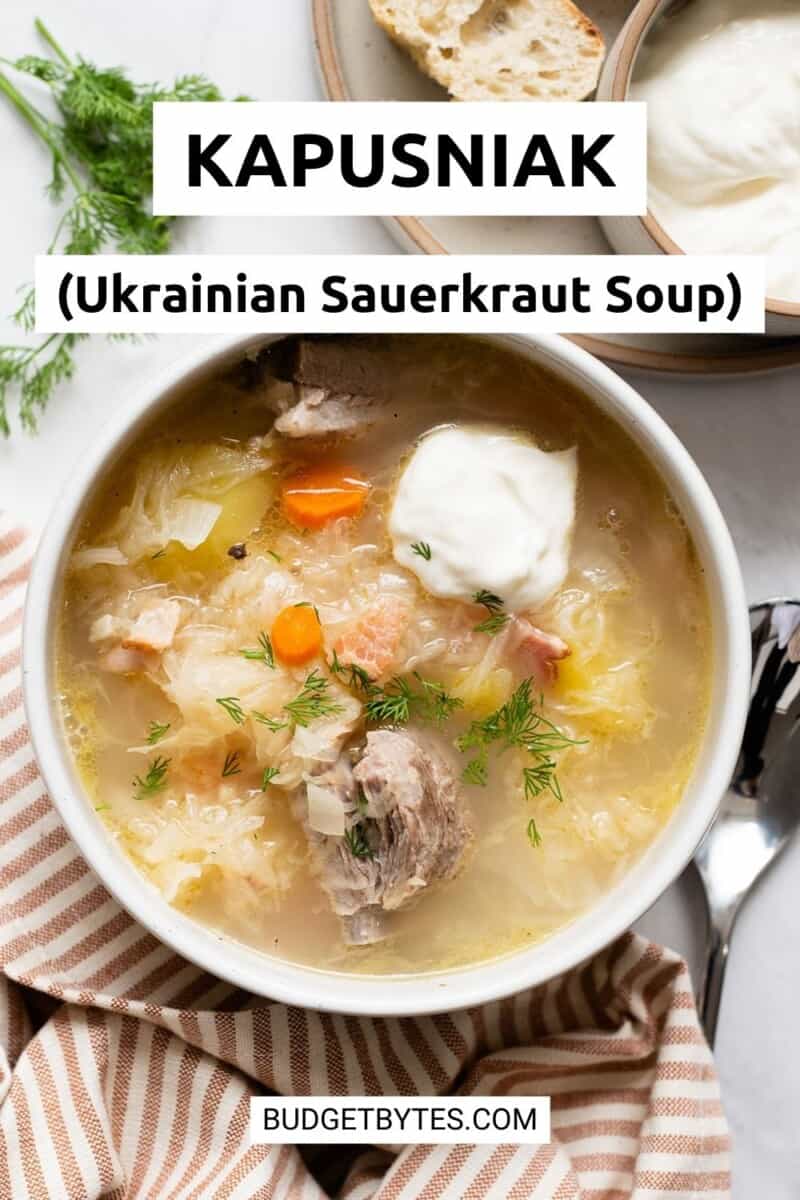

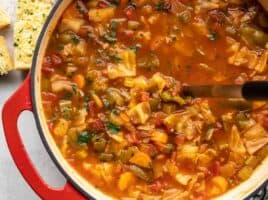


I haven’t made it let but so ready to try it. I read the comments and I see one comment is that she feels there is to much water, I like the taste of the ingredients so I would tend to agree with her. You mentioned that after the soup is made is when you put a dolup of sauterkraut in the soup, don’t you heat it or do you take right out of the jar. What I gather with that is you don’t cook it. Please let me know I’m dying to make it properly.
Thank you
Cold sour cream!
I love this soup! I’ve been making a version of it since college in the 70’s. I usually add a chopped apple, and maybe some beer. But otherwise, this same recipe. So good and tasty.
I think ratios of ingredients don’t work. Too much water. I didn’t even use the full amount of water and it was still too watery.
Simple and soooo tasty
I can’t se the part of rib that is not great for ribs alone and worked perfectly
Fantastic recipe! Thank you. It’s almost like my mom had made it…just how we remember it tasting. ❤️
It turned out really well but only if you follow the step by step photo instructions – the ingredients list leaves out garlic, & the instructions don’t mention chopping the bacon. Please update!
Otherwise this is a great recipe, I didn’t have carrots so I added celery that needed used up as well as frozen mixed vegetables, & I didn’t have ribs so I just used more bacon. Added mushroom broth that I happened to have as well as some chicken stock, & it worked great! Love a versatile recipe
I understand that the pork is essential to an authentic flavour but is there a way to adapt this recipe for a vegan diet?
Unfortunately, I just don’t see a way you could get similar flavors/richness without the pork. You’re welcome to give it a go and let us know how it goes though! You could just use vegetable stock instead of doing the pork and water step and use olive oil in place of the bacon. Then maybe add in some mushrooms to replace the pieces of pork. Again, it obviously will be missing some flavor/texture components and won’t be authentic, but it could still be delicious!
Very very confused by this recipe. It was extremely bland and watery – maybe this is authentic but it wasn’t expected. Not sure if we just didn’t use the right sauerkraut or what but it wasn’t edible for me. It also made twice as much food as we normally make in recipes like this so we’re stuck with a lot of the soup we didn’t enjoy. Garlic was also missing from the ingredients list but mentioned in the recipe so we free wheeled it on that. Anyone else experience this?
I made this soup last night with homemade sauerkraut we made this year and it was amazingly delicious! I will definitely be making some more of this soup, and sharing the recipe with friends and family! Thanks so much for sharing this recipe!
How could i modify this for a crock pot?
Very tasty! I loved the sauerkraut and the sour cream was a delicious addition. I will definitely make again, perhaps a vegetarian version with more seasoning.
I have a question, when did you do your cost estimates? The total cost of ingredients for me was almost four times yours. I spent $39.95.
Hi, I’ve been looking for a good sauerkraut soup recipe to replace the vegetarian one I lost years ago (better known as hangover soup). This meaty version fit the bill! I used pork breast bones, available occasionally at my local supermarket for only C$3.59/lb. I halved the recipe and added 1/2 t. paprika. I also used leftover ham broth (not too hammy, as it happened). Didn’t have to add salt but lots of pepper. Used unpeeled yukon gold potatoes. At the end, I slightly mashed the potatoes to make soup thicker. Worked a dream. Fresh dill really makes it. Very delicious and highly recommended! Suspect this would work with leftover ham too.
This was phenomenal!
I used my own homemade, fermented sauerkraut, which made it even more budget-friendly (and possibly more authentic!). I season my sauerkraut with caraway seeds, so that added some nice flavor.
I did a half batch of the recipe. The only meat I used was pork belly, and I used quite a bit less than the recipe calls for (160g), and it was still delicious. (Here in snow country in Japan, we’re having a blizzard, so supermarkets are a bit bare.) I added the top end of a daikon radish (tastes like turnip) to add some more bulk without increasing the cost much.
This is so good that I’m actually planning to make a second batch as soon as the leftovers are finished!
This is the best food I’ve ever eaten.
I used 14 oz. can store brand shredded sauerkraut and 2 #’s leftover pork roast and as you suggested 2 heaping cups freshly shredded cabbage . Thank you for this great recipe. I think I’m Ukrainian now.
Made this tonight and it is a real winner. I would maybe add an extra slice of bacon and more carrots next time.
I made this last night. This Norwegian-American probably made it a lot less “authentic” (sorry) by adding a couple packets that my daughter left behind of really good white wine Dijon mustard to it and by using boneless pork chops. I just used 8 cups of water. I guessed on the garlic and did two tablespoons, and we garnished each bowl with about a tablespoon of dill. Results/ BOMB. We are out and about most of today and will look forward to cozying to another bowl of it when we finally make it back here tonight.
About to make my 3rd batch. I think I’d give it 4 stars for taste but it’s very easy and inexpensive. Thank you!
I love sauerkraut but I was still a little scared of this recipe! I’m glad I tried it, though, it’s delicious. The sauerkraut adds a nice vinegar-y dimension to the soup without being overpowering. The soup is filling and hearty and the recipe nearly overflowed my big stock pot! Getting a little bacon piece in a bite is a nice smoky treat that contrasts perfectly with the sour broth.
You should rename this recipe to the Ukrainian spelling of the soup name instead of the Polish one. It’s confusing.
Hi – made this tonight and noticed a couple of things missing from your write-up. You mention garlic in the steps but not in the ingredient list. Dill is listed in the ingredients but not the steps. Looking forward to trying this dish again with more of the variations listed above!
I just made this tonight for my husband and it was a hit! Can this be frozen?
Hi, Nicole! You are welcome to freeze this, but one word of caution: Freezing cooked potatoes does change their texture in a way that some find unpleasant. I would suggest freezing one portion and seeing how you like it reheated before freezing the rest. Leftovers will also keep in the fridge for 4 days while you conduct this little experiment! ~Marion :)
Thank you! And thanks again for the amazing recipe!
Do you think a leftover ham bone would work for the pork meat? Sometimes ham can make things too…. hammy….
Hi, Lauren! You can definitely use that leftover ham bone, but yes — it will likely make the flavor of the final dish more “hammy” and potentially saltier. I’d also suspect there won’t be as much meat in the final dish using a ham hock instead of ribs or another cut of pork. If you try it, let us know how it turns out! Olena also gives other recommendations in the section of the blog post labeled, “WHAT KIND OF MEAT CAN BE USED IN KAPUSNIAK?” ~ Marion :)
I will try this recipe soon!!
What kind of potatoes work best? Would a Yukon golf or a russet work better?
Hi, Mae! While any type of potato (except purple varieties, which will turn the broth an unsightly shade of bluish-gray) will work in this recipe, I believe she used peeled russet potatoes. Yukon Gold would also be great (and doesn’t require peeling)! The primary difference between the two types is the final texture when cooked and really is mostly a matter of preference. Russets have a starchy, dry texture while Yukon golds are more waxy and creamy. ~Marion :)
I’m anxious to try this recipe! In the first photo of the meat (in the red Dutch oven), it looks like boneless country style pork ribs. In the second photo of the meat (on the cutting board), I can plainly see a bone protruding from each piece of pork.
So my questions are 1) can you can use boneless country-style ribs? And 2) if using ribs with bones, is baby back pork ribs okay? And 3) do pork short ribs and pork side ribs go by other names sometimes? I haven’t seen those two anywhere yet.
Lots of questions! Thanks, and Happy New Year to you!
I had the same question because my grocer didn’t have short ribs. I did use regular pork ribs that are longer in length, and the recipe turned out just fine. You end up taking them out of the water and removing the meat from the bone, so the length of the bone didn’t end up mattering. Hope that helps!
Hi, Jill! No need to be anxious! Any of the types you mentioned, or any type of pork, will work in this recipe. Olena discusses this in-depth in the section of the blog post labeled, “WHAT KIND OF MEAT CAN BE USED IN KAPUSNIAK?” I hope that helps! ~Marion :)
Hi Olena,
Great to see you here at Budget Bytes. This was one of my favourite soups made by my mom. I am so looking forward to making it! Your borscht recipe was excellent, I know this will be great.
Gosh this looks delicious. I love sauerkraut but am a vegetarian. I don’t suppose there’s an alternative?
I made this for NYE and had a vegan guest, so I ended up making a side batch where I sauteed the veggies in olive oil and used veggie broth instead of the pork water. My friend loved it, but for me, I think I would have wanted to add something like a protein substitute or more veggies.
Thanks for the suggestion!
This is actually Polish soup.
Yes Polish soup
Kapusniak is traditional polish soup. The spelling itself kapusniak its not Ukrainian. IT IS A POLISH SOUP. In other words SOUP FROM POLAND!
Tak Tomasz, it is Polish soup and even the word Kapusniak is a Polish word.
Delicious soup
It’s polish, not ukrainian.
Yes it sure is Polish soup
Oohoo! I love fermenting my own sauerkraut (have you ever thought of added some fermentation recipes to the site?), I’ll have to make some and then make this!
I would love to learn how to do fermentation. It sounds like a healthy thing to do. And very “Budget Byte.”
Hi, there! I will add your request to our “to-do list!” We have a number of yeasted bread recipes and a couple of pickled veggie recipes (both types of fermentation).
We haven’t tackled some of the tougher fermentation recipes like sourdough bread or kimchi or kraut (at least, not YET!) since these are more of a “project” than a recipe, and usually take a lot of time and specialized equipment. And while fermented foods are great products we love to incorporate into our cooking, some can also be dangerous to make (my former roommate tried to make kombucha, didn’t ‘burp’ the jar in time, and it exploded ALL OVER our kitchen.) and dangerous to consume if prepared incorrectly (storing improperly sealed food can cause the growth of bacteria, viruses, and parasites that cause foodborne illnesses) — so we just buy them from the store!
Here’s an interesting article to read on the subject: https://www.masterclass.com/articles/what-is-fermentation-learn-about-the-3-different-types-of-fermentation-and-6-tips-for-homemade-fermentation
~ Marion :)
Kapusniak (Kapuśniak) is traditional Polish soup not Ukrainian.
The author is from Ukraine so I feel like she’d know. She even mentions a variation that is made the polish way.
There is a lot of overlap between Ukrainian and Polish cuisine.
The cuisine of central/ Eastern Europe rarely is unique to one country. There are local twists to them, but they often are rather similar, especially the basic dishes. Similar dishes are well known in Austria, Germany, Belarus, the Baltic countries, … as well. This is not just due to the volatile shared history, but also due to the availability of ingredients. Sauerkraut and other fermented foods as well as cabbage in general, potatoes, pork….the backbone of central european cuisine.
капу́ста means cabbage in Russian, капуста is cabbage in Ukrainian and Belarusian, kapusta is cabbage in Polish, kapsas is cabbage in Estonian, kopūstai in Lithuanian, kāposti in Latvian, купус in Serbian, kupus in Croatian, káposztain Hungarian …so. This is a recipe for a cabbage soup and is named after its key ingredient, which is pretty similar in many- not just slavic- languages: Cabbage.
This recipe obviously comes from Ukraine, so why the urge to point out it’s not?
“This recipe obviously comes from Ukraine, so why the urge to point out it’s not?”
It obviously comes from Poland. And people have an urge to point it out because the Poles in the area shared with Ukraine were purged by Ukrainian death squads in 20th century by a man Ukraine parliament celebrated yesterday. So excuse us if we choose to be suspicious about appropriation of our cuisine by the people who celebrated the execution of our grandparents in the 1940s yesterday.
Drained or undrained kraut?
Hi, Patrice! We answer your question in the section of the blog called “WHAT KIND OF SAUERKRAUT TO USE.” (You don’t need to drain it. Just make sure not to use sauerkraut in white wine.) ~Marion :)
Do you debone the pork before putting back in the pot?
I would assume so, since it’s asking us to chop the cooked meat before adding back.
No, you can clearly see in the photo that the ribs still have the bones when poured back in the soup pot. But Americans don’t usually eat like that, so no reason you can’t bone the meat and add it back that way.